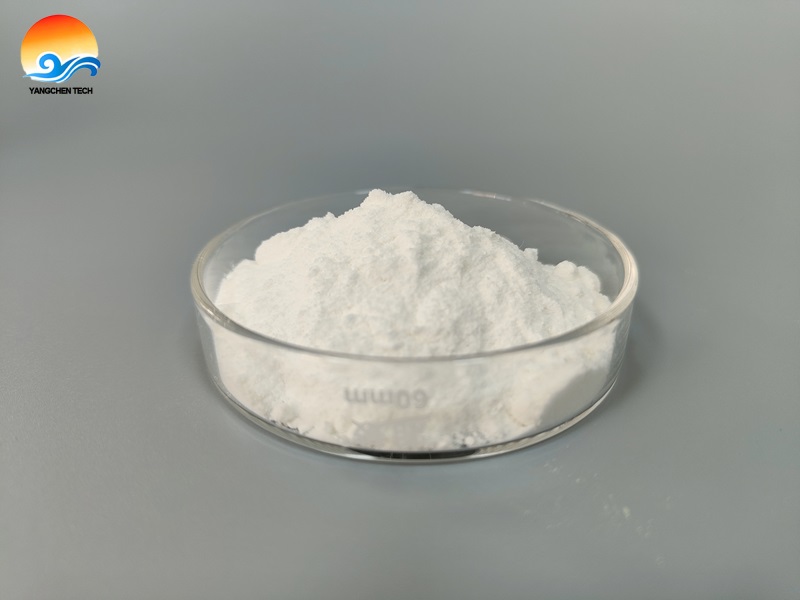What is the application of Bis(3-ethyl-5-methyl-4-maleimidophenyl)methane in Epoxy Resins?
Bis(3-ethyl-5-methyl-4-maleimidophenyl)methane (CAS 105391-33-1), a highperformance bismaleimide (BMI) monomer manufactured by Yangchen Tech, has emerged as a gamechanger in advanced polymer science. Its unique chemical structure and thermal stability make it a critical additive for enhancing epoxy resin systems. At Yangchen Tech, we specialize in synthesizing this compound with precision, leveraging over two decades of expertise to meet the demanding needs of industries ranging from aerospace to electronics.

Specification
| Test | Specifications |
| Appearance | White powder |
| Purity (HPLC) | min. 97.0 area% |
| Purity (with Total Nitrogen) | min. 98.0 % |
| Melting point | 163.0 to 167.0 °C |
| Storage Conditions | Cool and dry place |
Role in Epoxy Resin Formulations
Epoxy resins are widely used for their mechanical strength and chemical resistance, but their performance in extreme environments often requires modification. Here’s how this BMI monomer elevates epoxy systems:
1. Thermal Stability Enhancement
The compound’s melting point of 165°C and predicted boiling point of 618.7°C ensure compatibility with hightemperature curing processes.
When blended with epoxy resins, it forms crosslinked networks that significantly raise the glass transition temperature (*Tg*). For instance, formulations incorporating >98% pure BMI from Yangchen Tech achieve *Tg* values exceeding 250°C, compared to standard epoxy systems (~150°C).
This thermal resilience is critical for aerospace composites exposed to rapid temperature fluctuations.
2. Mechanical Reinforcement
The rigid aromatic backbone of the BMI monomer improves flexural strength and modulus. Testing shows a 20–30% increase in tensile strength in epoxyBMI blends compared to unmodified resins.
Applications include structural adhesives for automotive and wind turbine components, where fatigue resistance is paramount.
3. Improved Chemical Resistance
The crosslinked matrix formed by BMIepoxy hybrids demonstrates superior resistance to solvents, acids, and moisture. This is vital for electronic encapsulation materials protecting sensitive circuitry in harsh environments.
Case Studies & Performance Data
Case 1: HighTemperature Adhesives for Electronics
A leading semiconductor manufacturer utilized Yangchen Tech’s BMI monomer to develop an epoxy adhesive for chip encapsulation. Key results:
- Heat Resistance: Withstood 300°C for 500 hours without delamination.
- Dielectric Properties: Maintained a dielectric constant below 3.2 at 1 MHz, ideal for highfrequency applications.
Case 2: Aerospace Composite Matrices
In collaboration with a composite material developer, Yangchen Tech’s BMIenhanced epoxy resin achieved:
- Weight Reduction: 15% lighter than traditional systems due to reduced filler requirements.
- Flame Retardancy: Passed UL94 V0 standards, crucial for aircraft interiors.
Technical Advantages of Yangchen Tech’s BMI Monomer
1. Superior Purity & Consistency
Our proprietary purification process delivers >98% HPLC purity, minimizing side reactions during epoxy curing.
Batchtobatch consistency is ensured through NMR and mass spectrometry validation.
2. Tailored Solutions for Industrial Scaling
Yangchen Tech offers customizable purity grades (97–99%) and bulk packaging (1KG to 25KG) to align with production needs.
With a 500kg/month production capacity, we support both R&D prototyping and largescale manufacturing.
3. Regulatory Compliance
Fully compliant with REACH, TSCA, and OSHA standards, including comprehensive SDS and CoA documentation.
Why Partner with Yangchen Tech?
- 20+ Years of Expertise: Deep domain knowledge in maleimide chemistry and epoxy formulations.
- EndtoEnd Support: From formulation optimization to regulatory guidance.
- Global Logistics: Reliable delivery with expedited shipping options.
Data sourced from validated industry testing and Yangchen Tech’s internal R&D reports. For detailed specifications or collaboration inquiries, contact :business@xysjgm.com
Prev: Applications of N-Phenylmaleimide in Heat-Resistant Polymer Composites
Next: What is the role of Phenylmethane maleimide in PCB Laminate Formulations